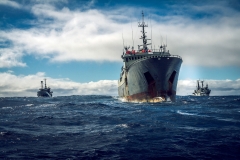
Chasing the Thunder: Film Screening and Panel Discussion
McCone Irvine Auditorium
Open to the Public
318 Items

McCone Irvine Auditorium
The Middlebury Institute’s Center for the Blue Economy is sponsoring eleven students from the International Environmental Policy program on summer internships with top marine organizations from the Bay Area to the Galapagos.
| by Charles Colgan
The Center for the Blue Economy will develop a baseline assessment of the ocean economies of Kenya and Tanzania, which can be used as a foundation for developing blue economy strategies in each country.
West Cliff Drive in the of City of Santa Cruz, California spans 2.5 miles of ocean views, cliffs and beaches. That stretch is home to an iconic lighthouse, prime surf spots, and is frequented by the wealthy and working class alike. But sea-level rise and storms threaten to undercut the road. This summer, the Center for the Blue Economy will help City managers determine the best way forward for West Cliff Drive.
| by Jason Warburg
A recent study by the Institute’s Center for the Blue Economy estimated the potential physical and economic impact of sea level rise on several Monterey landmarks.
| by Newswires; Rachel Christopherson
National Ocean Economics Program data cited in the against offshore oil drilling for New England.
| by Sea Grant California; Rachel Christopherson
With 3,427 miles of tidal coastline, California is one of the states expected to be most affected by sea-level rise.
| by Rachel Christopherson, KTVZ News, and & Office of Governor Kate Brown
Oregon has permanently banned offshore drilling in the midst of a federal push to open 90 percent of federal waters to oil exploration. The Center for the Blue Economy’s National Ocean Economics statistics are a part of the reason why.
| by Rachel Christopherson; Michael Conathan
The U.S. Senate Committee on Commerce, Science, and Transportation convened a hearing entitled, “Our Blue Economy: Successes and Opportunities,” on Wednesday, March 27, 2019. Center for the Blue Economy Advisory Council Chair, Mr. Michael Conathan, was there to testify.